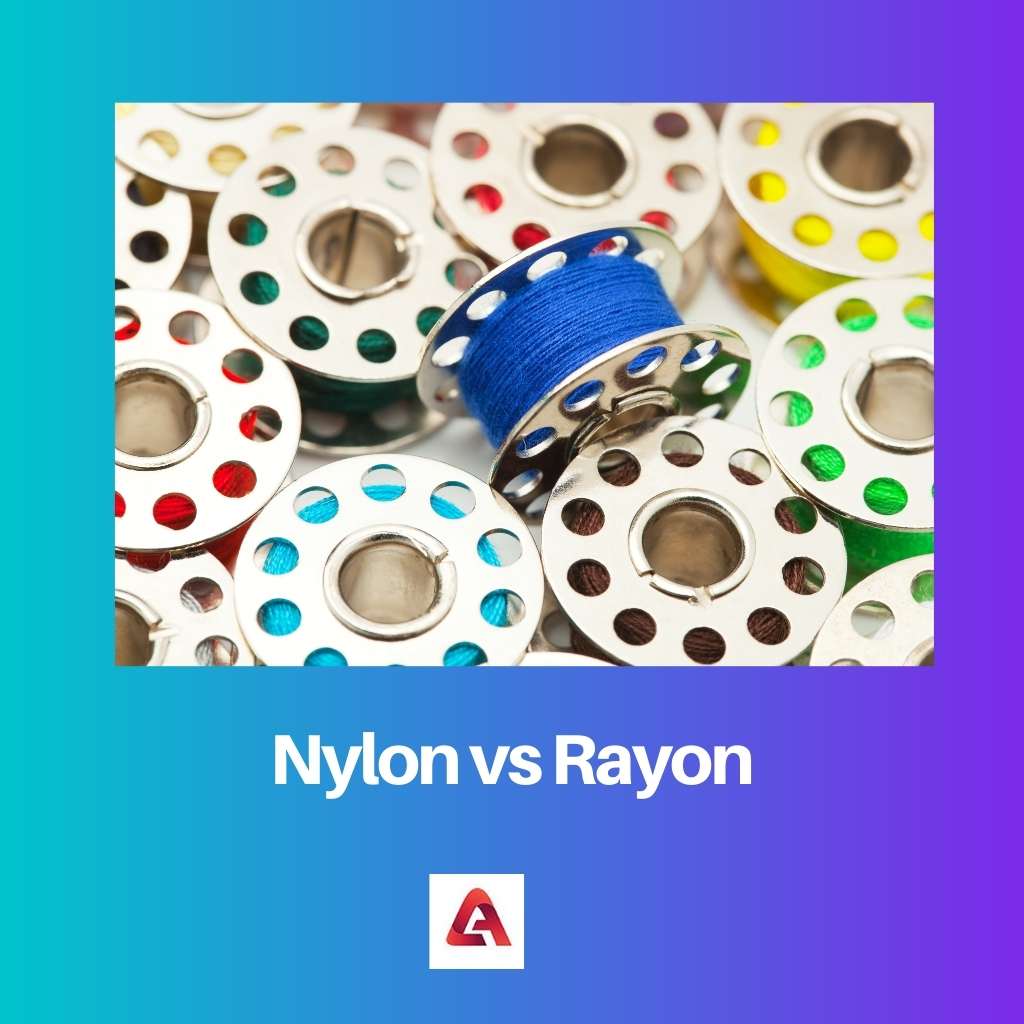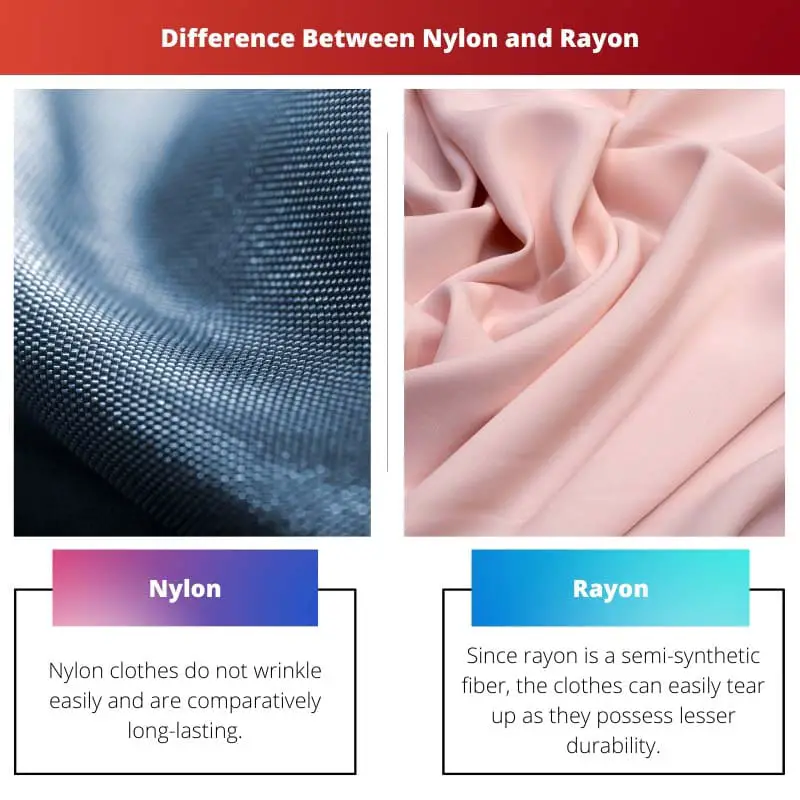Having the right material and its proper usage is the main goal before buying any kind of fabric. And today, we are going to discuss two different fabrics that are widely and popularly used by the population worldwide.
Before buying the fabric, one decides the correct texture, the favorable season to wear the fabric, and many more. We will differentiate between Nylon and Rayon with some examples in each category.
Key Takeaways
- Nylon is a synthetic polymer material, while rayon is a semi-synthetic material derived from cellulose.
- Nylon is more durable, resistant to abrasion, and has better elasticity than rayon.
- Rayon offers better moisture absorption and breathability, making it more comfortable for clothing than nylon.
Nylon vs Rayon
Nylon is a synthetic fiber made from polymers, while rayon is a natural fiber derived from cellulose. Nylon tends to be more durable than rayon due to its strength and resistance to stretching. Additionally, nylon has superior water resistance compared with rayon’s absorbent nature.

Nylon is a man-made fiber that is manufactured by combining several artificial materials. Nylon is a well-resistant fiber that can not be damaged easily and hence it is a bit long-lasting fiber.
On the other hand, Rayon is also a man-made fiber but made up of a particular natural substance and a few artificial substances, making it a semi-synthetic fiber.
Rayon is a good fiber but not as best as Nylon in terms of resistance. It has easily been damaged.
Comparison Table
| Parameters of Comparison | Nylon | Rayon |
|---|---|---|
| Texture | Nylon clothes do not wrinkle easily and are comparatively long-lasting. | Since rayon is a semi-synthetic fiber, the clothes can easily tear up as they possess lesser durability. |
| Maintainance | Nylon can be termed as a low maintaining product. | Comparatively, rayon clothes require a bit of attention. |
| Season | Nylon clothing products are more preferred during winter or cold reasons. | Generally, in the summer or autumn season, rayon clothes are best suited for the skin. |
| Iron Temperature | Nylon clothes can not sustain high ironing temperatures. | Not too high, but a favorable ironing temperature can be used on rayon clothes. |
| Moisture Balance | Nylon can not control excessive moisture. | Somehow, rayon clothes can bear the atmospheric moisture. |
What is Nylon?
Nylon is a type of fabric that was introduced in America in the year 1939 and since then it is a widely used fabric to manufacture various types of resources.
A few products that are highly in demand by the nylon fabric are tents, sportswear, stockings, etc. By this, we can understand that it is quite long-lasting and can survive any kind of a stretch.
Tents are one of the necessities of camping and having a great tent is a must. Therefore, nylon tents are the best to pick.
It is a synthetic fiber and the manufacturing products included in the process are completely inorganic. Since now we know that nylon is a synthetic material and is the end product of petroleum, coal, and agricultural items.
By combing such inorganic materials with some other chemical we can get the fabric known as Nylon. It is a low-maintained product and is easy to keep as it does not get wrinkled or tears up easily.
Most people prefer nylon clothing or products during the winter or cold seasons as it does not absorb the moisture in the air and keep the person warm and cozy from the cold.
Nylon can bear up to 220 C, and therefore we can iron these clothes and the average temperature should be under 220 C.
It carries good resistance power and can not be damaged easily. It has great elasticity and is soft on the skin.
Rayon is a semi-synthetic fiber that is produced from a fiber called cellulose by recycling it. Since cellulose is an organic fiber and hence rayon is called semi-synthetic fiber.
It is the mixer of both organic and inorganic materials. Its been many decades since the advent of rayon and is dated as in the year 1884, in Frace.

What is Rayon?
Rayon has a very soft and light texture which is very gentle on the skin. It is also quite absorbent and quickly locks the moisture in it. It is one of the best-suited fabrics in summers or autumns.
Now as we know that it is soft and delicate, therefore we should take proper care of this fabric as it can tear up easily and is a high-maintained fabric.
The products that can be manufactured from rayon are dresses, blouses, curtains, etc. Because of its delicacy, we also need to be careful while ironing.
On an average note, rayon can be ironed to a suitable temperature of 150 C and not more than that as it can burn easily or wrinkle.
People prefer rayon can as absorbs moisture, light in weight, soft, etc. The clothes that come out of this fabric are also elegant and chic.
And last but not the least, one more tip for maintaining rayon is that if you see a can thread coming out then you should cut it with a scissor instead of pulling it out.

Main Differences Between Nylon and Rayon
- Since the quality of nylon clothes is synthetic and hence they can not get wrinkled easily. On the other, before wearing rayon clothes, you need to iron them as it gets wrinkled.
- Nylon clothes are easy to go as they are low-maintenance products. On the other hand, proper care is much needed for rayon.
- A cozy season is best to dress up in nylon clothing. On the other hand, during summer and autumn rayon clothes can be managed to be worn.
- Nylon clothing can not be ironed at high temperatures. On other hand, rayon is more suited for ironing.
- Nylon can not absorb moisture. On the other hand, we can lock the moisture in rayon.

- https://link.springer.com/article/10.1007/s10096-010-1064-2
- https://www.sciencedirect.com/science/article/pii/S0195670110001453
